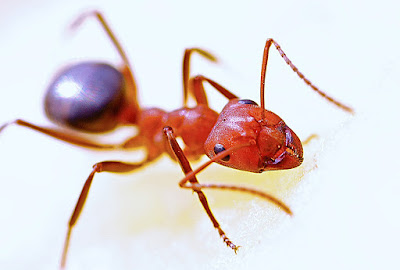It’s a fact of life, unless you live in Antarctica, that pests will make themselves at home in your house or apartment.
There are a variety of insect pests you need to think of and no two are alike. Rather than spraying toxic chemicals into
your home environment, consider using organic, non-toxic pest control. It’s safe for your home’s human occupants and for
your pets as well. Pests will show up in the air, your carpeting, your kitchen counter and other places you’d rather not
find them.
Let’s take a look specifically at ant control for your home or recreational areas outside. Remember that organic pest
control varies somewhat with the pest you’re dealing with and that just like with inorganic chemical pest control, you
don’t always use the same thing for ants as you do for fleas. Here’s a look at your organic options for ant infestation
in your home.
For the organic treatment of ants, a common summertime pest, you need to make sure your countertops are free of crumbs and
anything sticky or sweet. Cover your food well and keep your honey wrapped in a plastic baggy. Leave water sources off
during the night and don’t leave dirty dishes lying around. The same holds true for your deck or patio. Clean all food
up after an outdoor meal and teach your children not to throw food into the yard, like watermelon pieces or other sweet
foods.
Your organic pest control continues with a small spray bottle filled with soapy water that you can spray on the little
beasts. Put cucumber peels or slices in your kitchen, especially where the ants come in. You can also put tea bags with
mint tea in them or cloves around the places where the ants are very active. See if you can trace the column of ants back
to their entry point and set out a line of cayenne pepper, citrus oil, lemon juice, cinnamon or coffee grounds.
Ants won’t cross those lines.
For serious organic pest control against ants, mix a small amount of honey with an equivalent amount of Borax and aspartame. Put about a teaspoon and a half of the mixture in a bottle and set the bottle (without a lid) on its side where ants are active. This acts as a kind of toxic bait that the ants bring back to their colony. Keep small animals and children away from this toxic bait.
Another organic pest control trick is to leave a low-wattage light bulb or nightlight around where the ants are.
It disrupts their day and night pattern and can confuse their patterns of food hunting.
If ants are on your deck outside, use your organic pest control skills and put a few cloves of garlic, previously cut
into pieces, between the cracks of the deck slats. Ants don’t like garlic and will steer clear of the strong odor.
You can use some of the same indoor tricks outdoors, especially those involving the use of cayenne pepper, citrus oil,
lemon juice, cinnamon or coffee grounds. You can’t use the trick using the toxic bait outdoors as some small animals
can get into it.
There’s no reason to resort to harsh and dangerous chemicals, indoors or out, when perfectly acceptable organic pest
control for ants will keep your home ant-free in a much safer way. As long as you keep your kitchen and the rest of
your home clean and follow the above methods to discourage or kill ants, your summertime experience will be more
enjoyable and healthier for you and your family.











